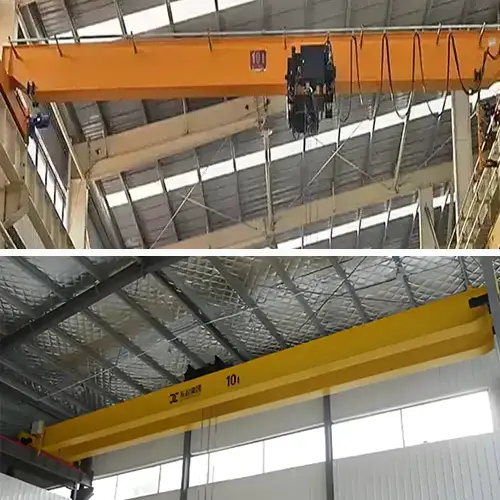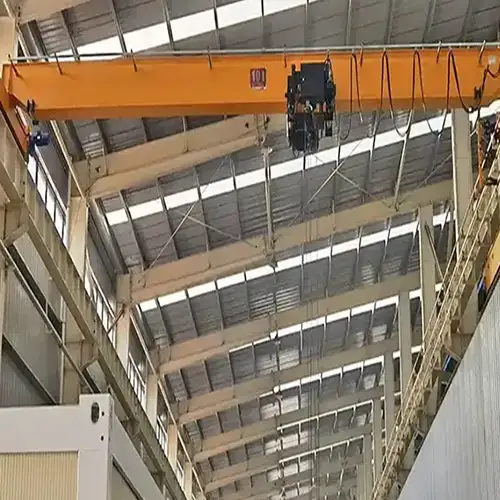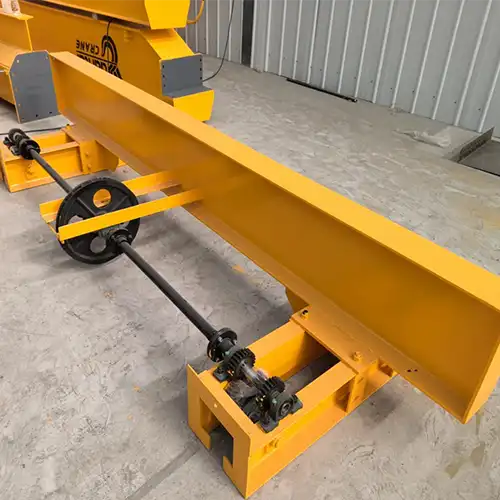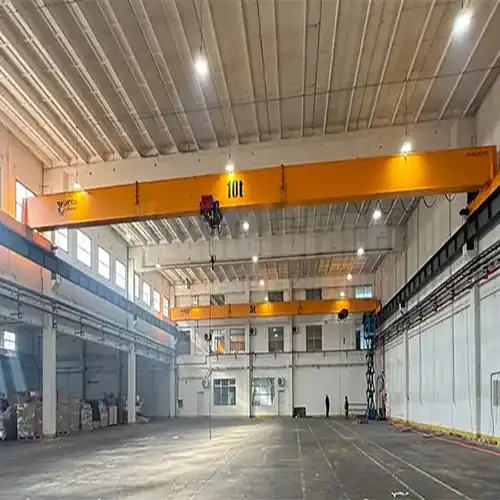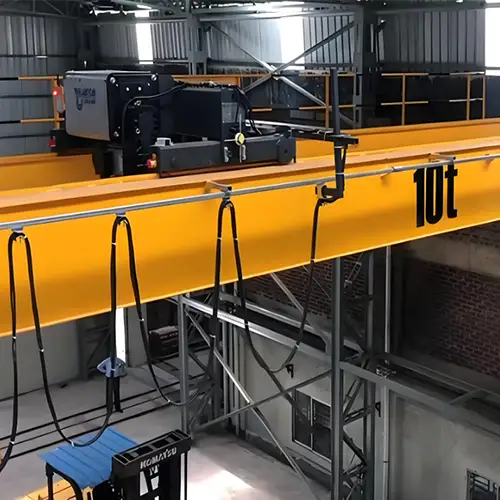Cost Analysis of 10 Ton Bridge Cranes: Single Girder Crane vs. Double Girder Crane
Explore the cost analysis of 10 Ton bridge cranes, comparing single girder and double girder options for effective decision-making.
Category: Bridge Crane
Your Trusted Overhead Crane Manufacturer & Supplier
Cost Analysis of 10 Ton Bridge Cranes: Single Girder Crane vs. Double Girder Crane
Explore the cost analysis of 10 Ton bridge cranes, comparing single girder and double girder options for effective decision-making.
Bridge cranes are vital lifting devices commonly used in various industries, including manufacturing, warehousing, and construction. They operate by moving loads along a horizontal bridge structure, allowing for efficient material handling and maximizing workspace. These cranes can be categorized into two main types: single girder and double girder.
The costs associated with each type is crucial for businesses looking to invest in a crane that meets their operational needs while remaining within budget. A thorough cost analysis helps in assessing not only the initial purchase price but also long-term expenses like maintenance, energy consumption, and operational efficiency.
This guide aims to compare the costs of 10 Ton single girder cranes versus double girder cranes, providing insights that will assist potential buyers in making an informed decision tailored to their specific requirements.
Initial Purchase Costs
Price Comparison
When evaluating the costs associated with 10 Ton bridge cranes, it's essential to recognize the significant price differences between single girder and double girder models. Below is a detailed overview of typical price ranges:
10 Ton Single Girder Cranes:
- Basic Models ($4,000 - $10,000): These are typically entry-level cranes suited for light-duty applications, featuring straightforward designs and essential functions.
- Mid-Range Models ($10,000 - $30,000): These cranes often come with enhanced features such as improved lifting mechanisms and better material quality, making them suitable for more demanding tasks.
- High-End Models ($30,000 - $45,000): These are robust cranes designed for heavy-duty use, incorporating advanced technology and high-quality components for maximum efficiency and durability.
10 Ton Double Girder Cranes:
- Basic Models ($6,500 - $15,000): Generally built for moderate lifting tasks, these cranes offer improved stability and a more complex design compared to single girder models.
- Mid-Range Models ($15,000 - $45,000): These cranes are often customizable and come equipped with features that enhance performance, making them suitable for industrial environments.
- High-End Models ($45,000 - $79,000): Designed for heavy and continuous use, these cranes incorporate cutting-edge technology, superior safety features, and high-quality materials.
This variation in pricing reflects the differences in design complexity, lifting capabilities, and intended applications.
Factors Influencing Costs
Several critical factors influence the purchase costs of bridge cranes, and These can aid in making a more informed decision:
Design and Complexity:
- Single Girder Cranes: These cranes have a more straightforward construction, which generally leads to lower manufacturing and installation costs. Their design is adequate for many standard applications, making them a popular choice for small to medium-sized businesses.
- Double Girder Cranes: Their more intricate design offers enhanced stability and can support larger loads, which justifies the higher price. These cranes are ideal for environments requiring frequent lifting of heavy materials, as they typically allow for better hook height and lifting capacities.
Material Quality and Construction:
- The choice of materials significantly impacts both initial costs and long-term durability. Cranes made from high-grade steel or other robust materials tend to be more expensive but provide greater reliability and a longer lifespan.
- The construction quality, including factors such as precision in assembly and welding techniques, also plays a crucial role. Cranes built with superior craftsmanship require less maintenance and are less prone to operational issues, which can lead to cost savings over time.
Manufacturer Reputation and Warranty Options:
- Purchasing from well-known manufacturers might involve higher upfront costs, but these companies often provide better customer service, comprehensive warranties, and support. This can be invaluable for ongoing maintenance and troubleshooting.
- Warranties can vary widely; some manufacturers offer extended warranty options that might raise initial costs but provide peace of mind and financial protection against unexpected repairs.
By thoroughly evaluating these factors alongside the price comparisons, businesses can choose a bridge crane that best fits their operational needs, budget considerations, and long-term strategic goals.
Operational Costs
Energy Consumption
Energy consumption is a vital aspect of the overall operational costs associated with bridge cranes.
- Single Girder Cranes: Generally, these cranes are more energy-efficient due to their lighter design. They require less power to operate, which can lead to lower energy bills over time. Their simpler mechanisms also contribute to reduced energy use, making them a cost-effective choice for facilities with moderate lifting needs.
- Double Girder Cranes: While they offer superior stability and lifting capabilities, double girder cranes tend to consume more energy due to their heavier construction and more complex operational mechanisms. However, advancements in technology, such as variable frequency drives (VFDs) and energy-efficient motors, can help mitigate some of these costs, providing better energy management and reduced operational expenses.
Maintenance Expenses
Maintenance is crucial for ensuring the longevity and reliability of bridge cranes, and costs can vary significantly between the two types.
- Routine Maintenance: Single girder cranes typically have lower routine maintenance costs because of their simpler design. Maintenance tasks may include regular inspections, lubrication, and minor adjustments, which are usually less frequent and less time-consuming.
- Common Repair Costs: For double girder cranes, repair costs can be higher due to their complexity and the potential for more extensive wear and tear on components. Common repairs might involve more specialized parts and labor, which can increase overall costs.
- Maintenance Frequency: Single girder cranes usually require less frequent maintenance compared to double girder cranes. However, the exact frequency will depend on usage patterns and environmental conditions. Regular maintenance schedules for both types should be adhered to, as neglecting maintenance can lead to costly breakdowns.
Labor Costs
Labor costs encompass both the operational and maintenance aspects associated with bridge cranes.
- Operation: Single girder cranes typically require fewer operators and less training, leading to lower labor costs. Their straightforward controls and simpler operation make them user-friendly, which can reduce the time spent on operator training.
- Maintenance: Double girder cranes may necessitate more skilled labor for operation and maintenance due to their complexity. This could lead to higher labor costs, especially if specialized training is required. Additionally, the need for more frequent maintenance could contribute to increased labor expenses over time.
By carefully considering these operational costs, businesses can better assess the total cost of ownership for both single and double girder cranes, allowing for a more informed investment decision based on their specific operational requirements.
Longevity and Durability
Lifespan Expectations
The lifespan of a bridge crane is influenced by various factors, including design, usage, and maintenance.
- Single Girder Cranes: Typically, single girder cranes have a lifespan of around 10 to 20 years, depending on their construction quality and usage conditions. They are ideal for light to moderate applications and can serve effectively in factories and warehouses with proper care and maintenance.
- Double Girder Cranes: In contrast, double girder cranes are designed for heavier and more demanding applications, often extending their lifespan to 20 to 30 years. Their robust construction allows them to withstand greater loads and frequent use, making them a more durable option for heavy-duty industrial settings.
Cost of Ownership Over Time
The total cost of ownership helps in making a more informed purchasing decision.
- Depreciation Rates: Both single and double girder cranes experience depreciation over time, but the rates can differ. Single girder cranes tend to depreciate more quickly due to their lower initial costs and simpler designs. Conversely, double girder cranes may depreciate more slowly, reflecting their higher initial investment and extended lifespan.
- Resale Value Considerations: When it comes to resale value, double girder cranes generally hold their value better due to their versatility and durability. This can be an important factor for companies considering future upgrades or replacements. Market trends also play a significant role; cranes in good condition with solid maintenance records can command higher resale prices.
By considering longevity and durability alongside initial and operational costs, businesses can make a more comprehensive evaluation of which type of crane will best suit their needs in the long run.
Performance and Efficiency
Load Handling Efficiency
Load handling efficiency is a critical factor in assessing the performance of bridge cranes, particularly for those with a 10 Ton capacity.
- Performance Metrics: Both single and double girder cranes are designed to handle loads efficiently, but they excel in different scenarios. Single girder cranes typically have a faster cycle time for lighter loads, making them ideal for operations requiring quick lifts and movements. Their design allows for smooth operation, which can enhance productivity in settings like warehouses and assembly lines. In contrast, double girder cranes can handle heavier loads with greater stability and precision, making them suitable for environments like manufacturing plants and heavy machinery facilities.
- Operational Flexibility: The versatility of load handling also plays a significant role. Double girder cranes often come with more advanced features, such as higher lifting heights and better load distribution, which can contribute to improved overall performance in demanding applications.
Impact on Workflow and Productivity
The choice between single and double girder cranes can significantly influence workflow and productivity.
- Operational Efficiency: Single girder cranes often result in quicker setup times and simpler operations, which can lead to improved workflow in environments with light to moderate lifting needs. Their lower weight and reduced complexity can facilitate faster movement of materials, directly impacting productivity.
- Downtime Considerations: Double girder cranes, while potentially more complex, offer enhanced stability and lifting capabilities that can reduce downtime during heavy lifting operations. Their robust design can handle larger loads more effectively, minimizing the risk of operational interruptions due to equipment failure or overloading.
By These performance and efficiency aspects, businesses can better align their crane selection with their operational goals, ensuring they choose the right type to maximize productivity and workflow efficiency.
Safety and Compliance Costs
Safety Features
Investing in safety features is crucial for the safe operation of bridge cranes, and costs can vary significantly between single and double girder cranes.
- Safety Equipment Costs: Both types of cranes may require additional safety equipment, such as limit switches, overload protection systems, and emergency stop buttons. For single girder cranes, these safety features might be less complex and therefore less costly, making them more budget-friendly. However, they still require essential components to ensure safe operation.
- Double Girder Cranes: On the other hand, double girder cranes, designed for heavier lifting, often necessitate more advanced safety systems to manage higher loads. This can include sophisticated monitoring systems and enhanced structural integrity features, which can lead to higher initial costs but ultimately contribute to safer operation in demanding environments.
Compliance with Regulations
Adhering to industry regulations is not just a legal requirement but also essential for ensuring workplace safety.
- Regulatory Expenses: Both single and double girder cranes must comply with local and international safety standards. Compliance costs can include inspections, certifications, and any necessary modifications to meet regulatory requirements. For single girder cranes, compliance might involve fewer modifications due to their simpler design, while double girder cranes may require more extensive evaluation and adjustments.
- Ongoing Compliance Costs: In addition to initial compliance costs, businesses should consider ongoing expenses related to safety audits and maintenance to ensure continued adherence to regulations. This may include training for operators, which is crucial for both types of cranes. Investing in proper training not only helps in compliance but also enhances overall safety in the workplace.
By factoring in safety and compliance costs, businesses can better understand the total cost of ownership and the importance of investing in features that enhance safety while meeting regulatory requirements.
Total Cost of Ownership (TCO)
Calculating TCO
The Total Cost of Ownership (TCO) is a comprehensive assessment that considers all costs associated with owning and operating a crane over its lifespan.
Methodology for Calculating TCO: To calculate TCO, businesses should account for several key components:
- Initial Purchase Price: The upfront cost of acquiring the crane, which varies between single and double girder types.
- Operational Costs: Ongoing expenses such as energy consumption, maintenance, labor, and parts replacement over time.
- Safety and Compliance Costs: Expenses related to safety features, equipment, and meeting industry regulations.
- Depreciation: Understanding how the crane's value decreases over time can affect overall ownership costs and resale value.
By gathering data on each of these components, businesses can create a comprehensive TCO analysis that reflects the true financial impact of their crane investment.
Comparative Analysis
A side-by-side comparison of TCO for 10 Ton single girder and double girder cranes provides valuable insights for decision-making.
TCO Overview for Single Girder Cranes:
- Initial Costs: Typically lower initial purchase prices ($4,000 - $45,000).
- Operational Efficiency: Lower energy consumption and maintenance expenses contribute to reduced ongoing costs.
- Safety Costs: Basic safety features may result in lower compliance and equipment costs.
TCO Overview for Double Girder Cranes:
- Initial Costs: Higher purchase prices ($6,500 - $79,000) reflect more robust construction and features.
- Operational Costs: While potentially higher due to energy use and maintenance, they provide better stability and handling for heavier loads.
- Safety and Compliance Costs: Enhanced safety systems may lead to increased compliance costs, but these investments contribute to higher safety standards in heavy-duty environments.
By evaluating TCO, businesses can make informed decisions on which crane type aligns best with their operational needs and budget constraints, ensuring a balanced approach to cost management and safety.
Conclusion
In conclusion, The cost dynamics between single girder and double girder cranes is essential for making informed purchasing decisions.
The analysis highlights that single girder cranes typically offer lower initial purchase prices and operational costs, making them an attractive option for lighter material handling tasks. In contrast, double girder cranes, while more expensive upfront, provide enhanced lifting capacities, stability, and safety features, justifying their higher total cost of ownership in heavy-duty applications.
For businesses focused on budget constraints and simpler lifting tasks, single girder cranes may be the ideal choice due to their cost-effectiveness and ease of maintenance. Conversely, organizations operating in environments requiring high load capacities and rigorous safety standards should consider investing in double girder cranes despite the higher initial and ongoing costs.
Ultimately, the decision between single and double girder cranes should not be based solely on initial price but rather on a comprehensive analysis of total costs over the crane's lifespan. By carefully evaluating operational needs, safety requirements, and long-term financial implications, businesses can choose the crane type that best aligns with their operational goals and budgetary limits. Making an informed decision ensures not only financial efficiency but also enhances workplace safety and productivity.
Related Products

Latest project
150 Ton Overhead Crane Installation Feedback – Paraguay Case
QDX 150 ton overhead crane in action in Paraguay. Installation photos, video, and client feedback show performance, safety, and heavy-lifting efficiency.
Free consultation to Confirm Parameters & Specifications and Get
Latest Crane Price & Crane Rate.
- Types of overhead cranes : _______?
- Optional: Overhead travelling crane, goliath gantry crane,Slewing jib crane, Single girder or double girder crane,small portable crane or kbk crane, etc.
- Capacity of overhead crane: _______?
- Optional: 0.25ton, 0.5 ton, 1 ton, 2 ton, 3ton, 5 ton, 10 ton,15ton, 20ton, 25 ton, 30ton,35ton, up to 550ton, etc.
- Crane span & lifting height : _______?
- Crane travelling length : _____?
- Control of overhead crane:_______?
- Optional: pendant/ remote/cabin control
- Voltage supply of overhead crane:_____?
- Eg,: 380V50/60HZ,3Phase or others,etc.
- Application/usage of crane:_______?
- Eg,: Steel mill, ,injection mold, cement,stone, concrete,granite, general manufacturing, etc.
Just leave a message via the contact form and our hoist and crane engineer will contact you with in 24working hours.
Get In Touch
